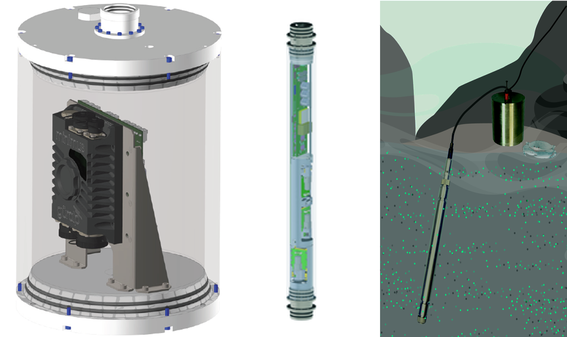
Chapter 2. Introduction
Thank-you for purchasing a Güralp Maris Ocean Bottom Seismometer.

2.1 Description
The Maris temporary stand-alone system is a state-of-the-art ocean-bottom seismometer comprising:
A Maris triaxial broadband digital seismometer, fully operational at any angle with velocity response flat from 120 seconds up to 200 Hz and a clip level of ±12 mm/s. An ROV handle is provided with the sensor.
A Minimus 24-bit data-logger enclosed in a titanium canister.
A set of 8 rechargeable lithium-ion battery packs with a nominal voltage of 7.4 V and 378 Ah capacity. All battery packs are connected in parallel inside the Minimus canister so the complete system has a nominal voltage of 7.4 V and a capacity of 3024 Ah. Each battery is supplied with a 3 m power cable with 3-pin SubConn connector at both ends (CAS-OBS-0144).
Two battery chargers.
A 5 m test cable for the Maris interface (CAS-OBS-0159) with a MIN-K connector at the instrument end and Ethernet (10BASE-T/100BASE-TX), serial and power 48 V (not used by the Maris stand-alone system) connectors at the "user" end.
A 3 m sensor cable with F60 connectors at both ends - used to power and control the Maris digital sensor.
A Minimus GNSS receiver with an integrated 10 m cable to a 14-pin LEMO connector.
A GNSS cable adapter from a SubConn 8-pin male to a LEMO 14-pin socket connector.
The Maris stand alone portable OBS is suitable for deploying at water depths of up to 3000 m for a period of maximum 1 year.
The Maris and the Minimus cases are all composed of titanium grade 5 to protect the instruments against water pressure and corrosion. The battery canisters are made of aluminium alloy, hard anodized and NITUFF® treated (this process involve the insertion of Teflon particles into the aluminium oxide matrix attained through hard anodizing).
Insertion of the Maris sensor into the sea floor minimises ambient noise to produce exceptional data quality.
The Maris is equipped with a ±2 g MEMS accelerometer and an internal magnetometer which gives an indication of the instrument tilt and heading.
2.2 Applications
Local, regional and global seismic monitoring
Monitoring of sub-sea hazards
Temporary Reservoir Monitoring (PRM)
Temporary ocean observatories
2.3 Summary of key features
Suitable for depths of up to 3000 m
Subsurface burial for improved data quality
Designed to be a stand-alone system for temporary deployment
Suitable for on-site data digitisation
Ethernet stream via dry-mateable connector
Suitable for installation via ROV